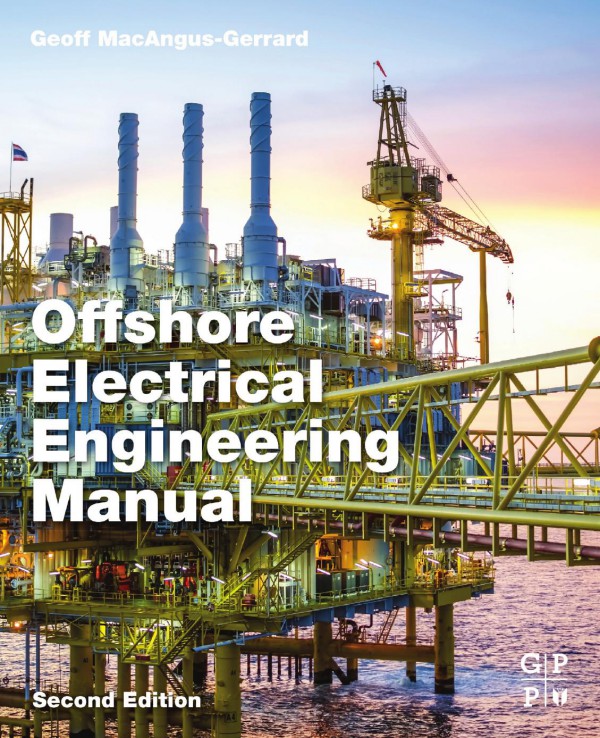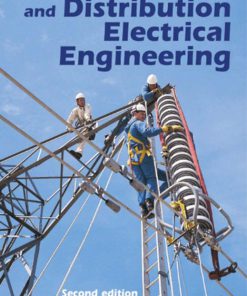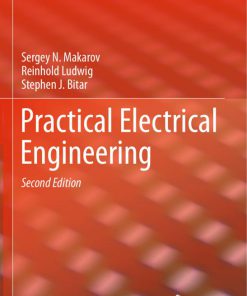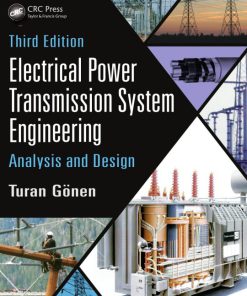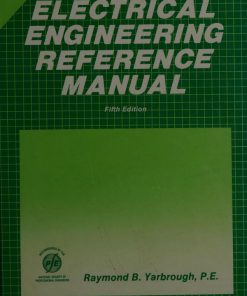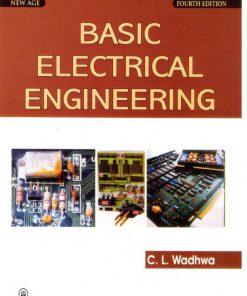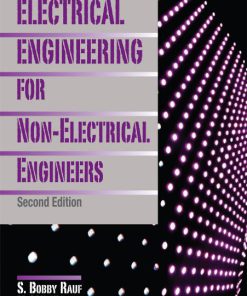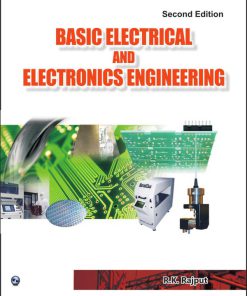(Ebook PDF) Offshore Electrical Engineering Manual 2nd edition by Geoff Macangus-Gerrard 0123854997 9780123854995 full chapters
$50.00 Original price was: $50.00.$25.00Current price is: $25.00.
Authors:Geoff Macangus-Gerrard , Series:Electrical Engineering [176] , Author sort:Macangus-Gerrard, Geoff , Languages:Languages:eng , Published:Published:Mar 2018 , Publisher:Elsevier
Offshore Electrical Engineering Manual 2nd edition by Geoff Macangus-Gerrard – Ebook PDF Instant Download/DeliveryISBN: 0123854997, 9780123854995
Full download Offshore Electrical Engineering Manual 2nd edition after payment.

Product details:
ISBN-10 : 0123854997
ISBN-13 : 9780123854995
Author : Geoff Macangus-Gerrard
Offshore Electrical Engineering Manual, Second Edition, is for electrical engineers working on offshore projects who require detailed knowledge of an array of equipment and power distribution systems. The book begins with coverage of different types of insulation, hot-spot temperatures, temperature rise, ambient air temperatures, basis of machine ratings, method of measurement of temperature rise by resistance, measurement of ambient air temperature. This is followed by coverage of AC generators, automatic voltage regulators, AC switchgear transformers, and programmable electronic systems.
Offshore Electrical Engineering Manual 2nd Table of contents:
Part 1. Introduction and Scope
Chapter 1. The Offshore Electrical Dimension
Introduction
Marine Environment
Hazards Offshore
Electrical System Design Criteria
Description of a Typical System
Chapter 2. The Offshore Electrical Environment
Introduction
Safety
Isolated Situation
Environment
Water Hazards
Hydrocarbon Hazards
Distribution Configuration
Modular Construction
Subsea Cable Versus On-Board Generation
Part 2. Offshore Electrical Systems and Equipment
Chapter 1. Insulation and Temperature Ratings of Equipment
Insulating Materials
Hot-Spot Temperatures
Temperature Rise
Ambient Air Temperatures
Basis of Machine Ratings
Method of Measurement of Temperature Rise by Resistance
Measurement of Ambient Air Temperature
Typical Alternator Heat Run Procedure
Do Not Readjust AVR During Heat Run
Ratings for Variable Speed Motors
Thermal Overloads and Motor Thermal Protection
ATEX EX ‘E’ Increased Safety Certified Motors
Chapter 2. Alternating Current Synchronous Generators
Introduction
Principals of Operation
The Brushless Alternator
Generator Capability Diagram
Parallel Operation of Generators
Load Sharing of Generators
Note on Compounding
Load–Voltage Characteristics (Regulation)
Chapter 3. Emergency Generators
Emergency Generation
Chapter 4. Prime Mover Selection Criteria
Introduction
Gas Turbines
Reciprocating Engines
Fuel Gas Pressure
Fuel Gas Temperature and Combustion Knock
Spark Duration and Voltage
Fuel Gas Disturbances
Load Profiles
Cooling Systems
Lube Oil Systems
Governors
Alternators and Excitation Systems
Neutral Earthing
Starting Requirements
Key Services Generation
Chapter 5. Generation and Distribution Switchgear and Transformers
Switchgear – General Requirements
The Mechanism of Short Circuit Current Interruption
Breaking Current
Types of Interrupter
Switchboard Construction
Drilling Supplies
Living Quarters Supplies
Process Area Distribution
Transformers
Chapter 6. Direct Current Generators
Introduction
Compound-Wound Generators
Adjustment of Compounding
Parallel Operation
Chapter 7. Direct Current Switchgear
Introduction
Switching Direct Currents
Specification
Chapter 8. Electrical Cables
Selection
Installation
Transits, Glands and Connectors
Bus Ducting
Cables for Intrinsically Safe Circuits
Chapter 9. Motors
Introduction
Voltage Levels
Starting
Speed
Pole Configuration
Cooling and Ingress Protection
Particular Applications
Chapter 10. Motor Control Gear
Introduction
Low-Voltage Switchgear and Motor Control Centres for Offshore Use
Motor Control Centre Software
Medium-Voltage Starters
Chapter 11. Power Electronics (Semiconductor Equipment)
Introduction
Environmental Conditions
Uninterruptible and Secure Power Supplies
Direct Current Supplies
Alternating Current Supplies
Selection of Voltage Tolerances
Batteries
Sealed Cells
Solid-State Controllers
Direct Current Variable-Speed Drives
Alternating Current Variable-Frequency Drives
Variable-Speed Drive or Variable-Frequency Drive
Chapter 12. Process Drives and Starting Requirements
Introduction
Voltage Levels
Starting
Speed
Pole Configuration
Cooling and Ingress Protection
Special Applications
Reciprocating Pumps and Compressors
Gas Compressors
Direct Current Drilling Motors
Power Swivels
Seawater Lift Pumps
Diesel–Electric Fire Pumps
Fire Pump Diesel Engine Starting Requirements
Downhole Pumps
Main Oil Line and Water Injection Pumps
Chapter 13. Subsea Supplies and Cathodic Protection
Introduction
Subsea Power Supplies
Diver’s Life Support Equipment
Subsea Completion Modules
Diving Chambers for Saturation Diving
Inductive Couplers
Subsea Umbilicals and Power Cables
Cathodic Protection
Galvanic Anode Systems
Cathodic Protection Calculations
Chapter 14. Offshore Lighting
Introduction
Lighting Calculations
Calculation Procedure
Illuminance at a Point
Floodlighting
Accommodation Lighting
Drilling Areas
Laydown Areas
Helidecks
Jacket and Leg Lighting
Navigational Lighting
Walkways, Catwalks and Stairways
Emergency Escape Lighting
Routine Maintenance
Chapter 15. Process Control and Monitoring Systems
Introduction
Process Control Systems
Process Shutdown System
Fire and Gas Considerations
Emergency Shutdown System
Chapter 16. Transformers
Introduction
Transformer Construction
Transformer Regulation
Chapter 17. Telecommunications – Internal and External
Internal Communications
Redundancy, Diversity, Survivability and Safety Issues
External Telecommunications
Redundancy, Diversity and Safety Issues
Notes
Part 3. Design Project Organization
Chapter 1. Notes on Detailed Design Project Organisation and Documentation
Introduction
Technical Organisation of the Design Programme
Material and Equipment Handling and Storage
Erection Procedure
Part 4. Electrical Faults and Protection Devices
Chapter 1. Alternator Faults and Protection Devices
Introduction
Chapter 2. Transformer Faults and Protection Devices
Transformer Faults
Magnetising Inrush
Overcurrent Protection
Restricted Earth Fault Protection
Differential Protection
Oil and Gas-Operated Devices
Parallel Transformers and Intertripping
Chapter 3. Motor Faults and Protection
Motor Winding Electrical Faults
Motor Mechanical Faults
Abnormalities in the Driven Machinery
Abnormalities in the Supply System
Overload Protection
Stalling Protection
Phase Unbalance Protection
Conventional Relay Types
Static and Microprocessor-Based Relay Types
Additional Protection for Synchronous Motors
Detection of Motor Faults on Large Motors With the Rogowski Coils
Chapter 4. Busbar Protection
Busbar Faults
Overcurrent and Directional Overcurrent Protection
Unrestricted Earth Fault Protection
Frame Earth Protection
Differential Protection
Chapter 5. Feeder Protection, Conductor Sizing, Load Flow and Fault Calculation
Fuses
Miniature Circuit Breakers
Overcurrent and Earth Fault Protection
Sizing of Conductors
Worked Example: Fault Calculation
Chapter 6. Calculation of Load Flow, Prospective Fault Currents and Transient Disturbances
Fault Calculation
Standard Methods of Calculation
IEC 61363
IEC 60909
Digital Methods of Fault Calculation
Digital Simulation of System Disturbances
Transient Simulations and Harmonic Analysis
ETAP Short Circuit Analysis Software
Unbalanced Short Circuit Analysis for Multiple and Single Phase Systems
IPSA Short Circuit Analysis Software
Power Tools for Windows
Proving the Software
Manual Calculations
Chapter 7. Protection and Discrimination
Introduction
Worked Example (Continued): Relay Setting of Typical MV Platform Scheme
Overcurrent Protection
Data Requirements
Overcurrent Relay Setting
Coordination
Earth Fault Relay Setting
CT Saturation
Coordination
Worked Example: Setting Voltage Controlled Overcurrent Relays
Chapter 8. Power Management
Generator Controls
Chapter 9. Harmonics
Introduction
Overheating of Motors
Overheating of Transformers and Increased Associated Losses
Resonance Effects
Uninterruptible Power Supplies
Switch Mode Power Supplies
Percentage Distortion Definition
Current or Voltage Total Harmonic Distortion
Part 5. Installation
Chapter 1. Installation Practice
Switchgear and Motor Control Centres
Distribution Transformers
Motors and Generators
Lighting and Small Power
Secure Power Supply Systems
Communications
Cable Support Systems
The Decommissioning and Removal/Abandonment Phases
Written Schemes of Examination
Chapter 2. Electrical System Earthing
Introduction
Platforms
Electrical Earths
Instrument/Communications Earths
Intrinsically Safe Earth
Equipotential Bonding
Ships
Lightning Protection
Chapter 3. Environmental Protection
Introduction
Weather and Sea Protection
Enclosure Ingress Protection
Structural Considerations
Noise Control
Prime Movers
Motors
Chapter 4. Hazardous Area Installation
Introduction
Hazardous Area Applications
Temperature Considerations
Explosion-Proof Ex ‘d’ Equipment (Older ‘Flameproof’ Certification is Similar)
Explosion-Proof Equipment Groups
Increased Safety Ex ‘e’ Equipment
Terminals
Enclosure
Ex ‘nA’ Non-Sparking
Non-Sparking: Ex ‘N’ (Now Obsolescent)
Pressurised: Ex ‘p’
Intrinsic Safety – Ex ‘i’a and Ex ‘i’b (Refer to BS EN 60079-11:2012)
Level of Protection ‘ia’
Level of Protection ‘ib’
Level of Protection ‘IC’
‘Simple’ Apparatus and Components
Loop Calculations for Galvanic Barriers
Selection of Other Equipment
Avoidance of Ignition by Non-Electrical Equipment (Refer BS EN ISO 80079-36 & 37)
Avoidance of Ignition by Radio and Radar Transmissions (Refer to PD CLC/TR 50427)
Hazard Source Schedules
Defining Boundaries
Ventilation
Logic of Area Classification
Selection of Motors for Hazardous Areas
Mixing Hazardous Area Certified Equipment
Part 6. Specific Systems and Vessel Types
Chapter 1. Notes on Dynamic Positioning and Ballast Control for Floating Installations
Dynamic Positioning
Integrated Control Systems
Propulsion Redundancy
Ballast Control Systems
Ballast Control: Basic Control Features
Chapter 2. Floating Production, Storage and Offloading Units
Introduction
Safety Critical Systems
Chapter 3. Semisubmersibles and Mobile Offshore Drilling Units
Introduction
Power Generation
Pontoon and Leg Equipment Installation
Watertight Door Monitoring and Ballast Control Systems
Electrical Drilling Direct Current and Alternating Current Semiconductor Drives
Cement Kill Pumps and Controls
Drilling Mud Facilities
Fire and Gas Systems and Ventilation Control on Rigs
The UK Offshore Safety Case Legislation
Chapter 4. Self-Elevating Rigs
Introduction
Frequent Duties
Main Facilities
Chapter 5. Tension Leg Platforms
Introduction
Tension Leg Platform in Oil and Gas Installations
Tension Leg Platform as a Wind Turbine Structure
Chapter 6. Notes on Offshore Renewable Energy Substation Platforms
Introduction
Description
Hazards
Part 7. Commissioning
Chapter 1. Introduction to Commissioning
Chapter 2. Generators
Introduction
Running the Prime Mover
Chapter 3. Switchgear
Air Break Switching Devices and Fuses Rated for Use at Voltages Below 1000V
Air Circuit Breakers/Switchgear Rated for Use at Voltages Above 1000V
Oil Switchgear Over 1kV
Vacuum Circuit Breakers
Sulphur Hexafluoride Switchgear
Chapter 4. Protection and Control
Precommissioning
Protection Scheme Commissioning
Voltage Transformers (Refer to BS EN 61869 and BS EN 50482)
Current Transformers
Protection Relays
Closing and Tripping
Chapter 5. Large Motors
Precommissioning
Motor Commissioning Tests
Chapter 6. Protection, Monitoring and Control
Precommissioning
Permit-to-Work Systems
Control and Monitoring System Commissioning
Cause-and-Effect Matrices
Safety, Shutdown and Protective Circuits and Devices
Part 8. Reliability, Maintenance and Logistics
Chapter 1. Reliability
Introduction
Duplication and Redundancy
Failure Mode, Effects and Criticality Analysis
Circuit Breaker Illustration
Fault Trees
Reliability Block Diagrams
Confidence Limits
Example 8.1.1
Example 8.1.2
Chapter 2. Maintenance and Logistics
Rationalisation of Spares
Accessibility and Communications
Maintenance Intervals and Equipment Specification
Scaffolding and Abseiling (Rappelling)
Transport, Accommodation and People Onboard Problems
Maintenance Scheduling Software
Part 9. Statutory Requirements and Safety Practice
Chapter 1. Introduction to UK DCR Regulations and the Duties of an Electrical ICP
Introduction
Background
Chapter 2. Preparation and Use of Performance Standards
Chapter 3. Notes on Safety Integrity Level Assessment for Electrical Engineers
Introduction
Safety Function
Safety Instrumented Function
Safety Instrumented System
The Safety Integrity Level Assessment Process
Determining Safety Integrity Levels – Process
Determining Safety Integrity Levels – Instrumentation
Safeguards
People also search for Offshore Electrical Engineering Manual 2nd:
offshore electrical engineering manual pdf
offshore electrical engineering manual
offshore cruising encyclopedia pdf
offshore electrical engineering manual by geoff macangus-gerrard
the electrical engineering handbook pdf
You may also like…
eBook PDF
(Ebook PDF) Basic Electrical Engineering 4th edition by Wadhwa 9788122429473 full chapters
eBook MOBI
(Ebook PDF) Electrical Engineering Experiments 1st edition by Chhalotra 9781683921158 full chapters

